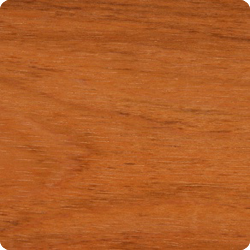Detailed Specs: Jatoba
Scientific Name: Hymenaea courbaril
Family: Leguminosae
Other Names: Cuapinol, Guapinol (Mexico), Guapinol (Central America), Locust, Kawanari (Guyana), Rode lokus (Suriname), Algarrobo (Spanish America), Jatahy, Jatoba (Brazil).
The Tree
May grow to a height of 130 feet with the trunk diameter being 5 to 6 feet. Trees less than 100 feet tall have a diameter of 2-4 feet. Boles are well formed and are often clear for 40 to 80 feet. They are basally swollen or buttressed in large trees.
The Wood
General Characteristics: The heartwood is salmon to orange brown when freshly cut and becomes russet to reddish brown when seasoned; often marked with dark streaks. The sapwood is usually wide with a white, pinkish or grey color. Texture is medium to rather coarse; grain mostly interlocked; golden luster; without a distinctive odor or taste.
Weight: Basic specific gravity (oven dry/green volume) 0.71 to 0.82; air dry density-52 to 61 pcf.
Drying and Shrinkage: This wood is rated as slightly difficult to air dry, it seasons at a fast to moderate rate with only slight checking and warp. Kiln schedule T3-C2 is suggested for 4/4 stock and T3-C1 for 8/4. Shrinkage green to oven dry: radial 4.5%, tangential 8.5%; volumetric 12.7%. Values are low for a wood of this density.
Working Properties: This wood is moderately difficult to saw and machine largely due to the fact of its high density, but except in planing it can be machined to a smooth surface. It is difficult to plane because of the interlocked grain, however, it is easy to glue and finishes satisfactorily. The steam bending properties are those similar to white oak.
Mechanical Properties: (First set of data based on the 2-in standard; the second on the 1-in standard.)
|
Moisture |
Bending Strength (psi) |
Modules of Elasticity (1000 psi) |
Maximum Crushing Strength (psi) |
| Green (74)
12% 12% (24) |
12,940
19,400 25,100 |
1,840
2,160 2,870 |
5,800 9,510 14,200 |
Janka side hardness at 12% moisture content 2350 to 3290 lb. Forest Products Laboratory toughness average for green and dry material is 23 inches – lb. (5/8 specimen).
Durability: According to laboratory evaluations the wood is very resistant to brown rot and white fungi; actual field exposure trials also rate the wood as very durable. The heartwood is also rated very resistant to dry wood termites; has little resistance to marine borers.
Distribution: Southern Mexico throughout Central America and the West Indies to northern Brazil, Bolivia and Peru. The tree’s best development is on ridges or slopes and high riverbanks.
Preservation: The heartwood is not treatable using open tank or pressure-vacuum systems. Only the sapwood is responsive.
Uses: Used where good shock resistance is needed such as in tool handles. Also used in steam bent parts, flooring, turnery, furniture, cabinet work, railroad crossties tree nails, gear cogs, wheel rims, and a variety of other specialty items. In addition, the seed pods contain edible pulp and exudes a rosin like gum known commercially as South American Copal.
References
– Chundnoff, Martin (1984), “Tropical Timbers of the World.” USDA Forest Service Ag. Handbook No.607.



